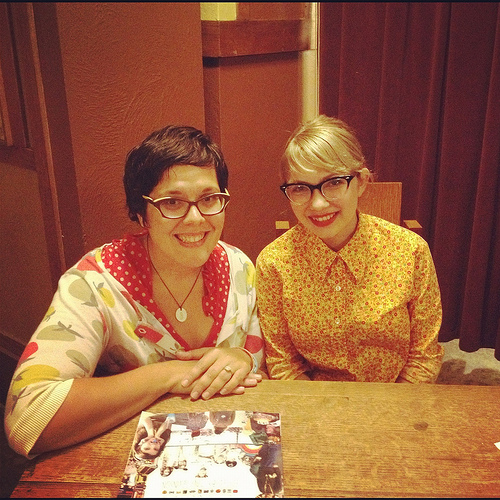
Gender Equity (+ Resources to Address It)
[flickr id=”8026954145″ thumbnail=”medium” overlay=”true” size=”original” group=”” align=”none”]
“This is what I want: female artists, please risk embarrassing yourself, put on your ugliest face, climb inside your mind at its worst. I want writing, art, communication among females that makes me cringe. I’m talking about hatred of our bodies, dependence on men and mirrors, passivity…all those generic “un-liberated woman” traits that are not supposed to apply to us intelligent 21st century girls and women who “know better” than to fall into these traps. Let’s talk about all of it!” – Anna McConnell, Stuffing Myself With Immanence
In the Elementary Education MAT program, we spend a lot of time discussing how to make the classroom equitable for all children. In my opinion, it is the single most important consideration for a teacher at the beginning of each year. Many strategies for doing this are simply good pedagogy, but others refer directly to some of the biases our culture has in place that students may have to overcome outside of school. I can’t identify with many of these biases, but I do strongly identify with gender equity. An easy example, I was never told as a child that I could “do” math well. I was praised repeatedly for my prowess as a writer and performer, but never for my skills in science or inquiry.
During adolescence, a very formative time in most students lives, I spent my money on copies of Seventeen Magazine and poured through it for tips for how to be a better version of myself. I was a preteen before the advent of the internet, so I didn’t know there were other girls like me out there. Girls who wanted to go to movies to discuss the plot arc and underlying themes, girls who read excessively, girls who loved to play tackle football with the neighbors. The girls represented as role models to me in most books, films, and tv shows were flawless. I understood that they were not real, but I also understood that they did not represent me. But what I didn’t understand was WHY they didn’t represent me. Was I the only flawed girl in the world?
[flickr id=”8026958026″ thumbnail=”medium” overlay=”true” size=”original” group=”” align=”none”]
Gender equity means allowing all students to have the same opportunities in class, while also employing strategies that take into consideration behaviors that may inhibit learning or participation for each gender. Teachers need to be on the front lines of fighting these biases so that their students do not develop opinions about their ability to learn about a subject that is not “normal” for their gender to excel at. For example, a resource from UC Davis notes a study that shows how girls, if interrupted, may feel that their response is wrong or invalid. They then go on to suggest that teachers employ strategies for interruptions to make sure that everyone in the classroom feels as if their voice has been heard.
However, gender equity does not mean tailoring an activity so that it is more “suitable” for a boy or a girl. For example, we recently looked at the game Lure of the Labyrinth in our math methods course. One of my classmates asked if the subject matter seemed uninteresting or “too gory” for girls. While initially it may seem like this is a way to think about equity in a lesson, assuming that a girl wouldn’t like an activity or task because of implied gender norms is applying a bias to the females in your classroom.
[flickr id=”8026965305″ thumbnail=”medium” overlay=”true” size=”original” group=”” align=”none”]
While making sure there is gender equity in each subject matter you teach, it is equally important to support character building of your students through adolescence. As students get older, they are increasingly influenced by their intake of popular culture and what it says about their gender. As I mentioned above, I wish I would have had the ability to go online and seek out girls who were like me. Unfortunately, popular culture is not equitable and will likely be sending some biased messages to teens.
There are, however, some very excellent things happening in young feminist culture right now that could really be utilized in the classroom to support all students. I know I’ve spoken of Rookie Magazine on the blog before, but it truly is a positive outpouring of content that is geared towards helping teenagers “figure it out.” Rookie shares a portrait of youth that is complicated and flawed, and it gives its readers permission to continually redefine themselves however they want. The initial editor’s note written by Tavi Gevinson ends by saying, “From here on out, you write your own handbook.” Rookie is something that I think could be very successfully employed in the classroom to help students navigate a very difficult period in their lives.
[flickr id=”8026956889″ thumbnail=”medium” overlay=”true” size=”original” group=”” align=”none”]
If this isn’t enough gender equity for you, I was able to find some amazing online lesson plans that help students tackle this subject matter. The first is from the Peace Corp and is titled, Investigating Gender Equality and Women’s Empowerment. This lesson is for a middle school classroom and successfully integrates Language Arts, Social Studies and Science. It also handily lays out the Common Core standards addressed. Unicef actually offers two full middle school units on gender equity. They are titled To Educate a Girl and Gender Equality: An Introduction. Both lessons include national standards for Social Studies, Language Arts, and Math. I would be very interested to know if anyone has tried out these lesson plans before and what they thought of them. If you have, please email me so we can discuss. Have a great week everybody!
[flickr id=”8026949183″ thumbnail=”medium” overlay=”true” size=”original” group=”” align=”none”]
